Non-Invasive Multi-Analytical Insights into Renaissance Wall Paintings by Bernardino Luini
Abstract
1. Introduction
2. Materials and Methods
2.1. Selection of Analysis Points


2.2. X-Ray Fluorescence (XRF) Spectroscopy
2.3. External Reflection Fourier Transform Infrared (ER-FTIR) Spectroscopy
2.4. Raman Spectroscopy
2.5. Visible Reflectance Spectroscopy
2.6. Hyperspectral Imaging
3. Results
3.1. The Marriage of the Virgin
3.1.1. Elemental and Molecular Spectroscopic Analyses
3.1.2. Visible Reflectance Spectroscopy
3.1.3. Hyperspectral Imaging
3.2. The Adoration of the Christ Child
3.2.1. Elemental and Molecular Spectroscopic Analyses
3.2.2. Visible Reflectance Spectroscopy
3.2.3. Hyperspectral Imaging
4. Discussion
5. Conclusions
Supplementary Materials
Author Contributions
Funding
Institutional Review Board Statement
Informed Consent Statement
Data Availability Statement
Acknowledgments
Conflicts of Interest
References
- Ward, J. Fresco Painting, Its Art and Technique, with Special Reference to the Buono and Spirit Fresco Methods; Chapman and Hall, Ltd.: London, UK, 1909; Available online: http://archive.org/details/frescopaintingit00wardiala (accessed on 11 July 2025).
- Pini, V.; Sironi, G. Bernardino Luini: Nuovi Documenti per la Sua Biografia; NED: Milano, Italy, 1993. [Google Scholar]
- Agosti, G.; Stoppa, J. Bernardino Luini e i Suoi Figli; Officina Libraria: Milano, Italy, 2014. [Google Scholar]
- Perer, M.L.G. Il Santuario della Beata Vergine dei Miracoli di Saronno; ISAL: Cinisello Balsamo, Italy, 1996. [Google Scholar]
- Repishti, F. Il santuario della Beata Vergine dei Miracoli di Saronno. In Il Giovane Borromini. Dagli Esordi a San Carlo Alle Quattro Fontane; Skira: Milan, Italy, 1999; pp. 166–167. [Google Scholar]
- Fovo, A.D.; Mazzinghi, A.; Omarini, S.; Pampaloni, E.; Ruberto, C.; Striova, J.; Fontana, R. Non-invasive mapping methods for pigments analysis of Roman mural paintings’. J. Cult. Heritage 2020, 43, 311–318. [Google Scholar] [CrossRef]
- Fioretti, G.; Tempesta, G.; Capotorto, S.; Eramo, G. Non-Invasive Characterisation of the Wall Paintings in the Byzantine Church of Palazzo Simi (Bari, Italy) and Digital Photogrammetric Survey for a Pigment Mapping. Coatings 2023, 13, 996. [Google Scholar] [CrossRef]
- Picollo, M.; Cucci, C.; Casini, A.; Stefani, L. Hyper-Spectral Imaging Technique in the Cultural Heritage Field: New Possible Scenarios. Sensors 2020, 20, 2843. [Google Scholar] [CrossRef] [PubMed]
- Rousaki, A.; Vandenabeele, P. In situ Raman spectroscopy for cultural heritage studies. J. Raman Spectrosc. 2021, 52, 2178–2189. [Google Scholar] [CrossRef]
- Volpi, F.; Vagnini, M.; Vivani, R.; Malagodi, M.; Fiocco, G. Non-invasive identification of red and yellow oxide and sulfide pigments in wall-paintings with portable ER-FTIR spectroscopy. J. Cult. Herit. 2023, 63, 158–168. [Google Scholar] [CrossRef]
- Nardo, V.M.; Renda, V.; Bonanno, S.; Parrotta, F.; Anastasio, G.; Caponetti, E.; Saladino, M.L.; Vasi, C.S.; Ponterio, R.C. Non-invasive investigation of pigments of wall painting in S. Maria Delle Palate di Tusa (Messina, Italy). Heritage 2019, 2, 2398–2407. [Google Scholar] [CrossRef]
- Bonizzoni, L.; Gargano, M.; Ludwig, N.; Martini, M.; Galli, A. Looking for Common Fingerprints in Leonardo’s Pupils Using Nondestructive Pigment Characterization. Appl. Spectrosc. 2017, 71, 1915–1926. [Google Scholar] [CrossRef]
- de Queiroz Baddini, A.L.; de Paula Santos, J.L.V.; Tavares, R.R.; de Paula, L.S.; da Costa Araújo Filho, H.; Freitas, R.P. PLS-DA and data fusion of visible Reflectance, XRF and FTIR spectroscopy in the classification of mixed historical pigments. Spectrochim. Acta Part A Mol. Biomol. Spectrosc. 2022, 265, 120384. [Google Scholar]
- Volpi, F.; Fiocco, G.; Gargano, M.; Albano, M.; Calvia, A.; Saviotti, F.; Delledonne, C.; Lee, C.; Rovetta, T.; Malagodi, M. Unveiling materials and origin of reused medieval music parchments by portable XRF and ER-FTIR’. Microchem. J. 2024, 205, 111224. [Google Scholar] [CrossRef]
- Grassi, S.; Fiocco, G.; Invernizzi, C.; Rovetta, T.; Albano, M.; Davit, P.; Gulmini, M.; Stani, C.; Vaccari, L.; Licchelli, M.; et al. Managing complex Synchrotron radiation FTIR micro-spectra from historic bowed musical instruments by chemometrics. In Proceedings of the 2019 IMEKO TC-4 International Conference on Metrology for Archaeology and Cultural Heritage (MetroArchaeo 2019), Florence, Italy, 4–6 December 2019. [Google Scholar]
- Bell, I.M.; Clark, R.J.H.; Gibbs, P.J. Raman spectroscopic library of natural and synthetic pigments (pre- ≈ 1850 AD). Spectrochim. Acta Part A Mol. Biomol. Spectrosc. 1997, 53, 2159–2179. [Google Scholar] [CrossRef]
- Burgio, L.; Clark, R.J.H. Library of FT-Raman spectra of pigments, minerals, pigment media and varnishes, and supplement to existing library of Raman spectra of pigments with visible excitation. Spectrochim. Acta Part A Mol. Biomol. Spectrosc. 2001, 57, 1491–1521. [Google Scholar] [CrossRef]
- Perri, A.; de Faria, B.E.N.; Ferreira, D.C.T.; Comelli, D.; Valentini, G.; Preda, F.; Polli, D.; de Paula, A.M.; Cerullo, G.; Manzoni, C. Hyperspectral imaging with a TWINS birefringent interferometer. Opt. Express 2019, 27, 15956–15967. [Google Scholar] [CrossRef]
- Keshava, N.; Mustard, J.F. Spectral unmixing. IEEE Signal Process. Mag. 2002, 19, 44–57. [Google Scholar] [CrossRef]
- Winter, M.E. N-FINDR: An algorithm for fast autonomous spectral end-member determination in hyperspectral data. In Proceedings of the SPIE’s International Symposium on Optical Science, Engineering, and Instrumentation, Denver, CO, USA, 18–23 July 1999; pp. 266–275. [Google Scholar] [CrossRef]
- Bevilacqua, N.; Borgioli, L.; Gracia, I.A. I Pigmenti Nell’arte: Dalla Preistoria alla Rivoluzione Industrial; Il Prato: Veneto, Italy, 2010. [Google Scholar]
- Derrick, M.R.; Stulik, D.C.; Landry, J.M. (Eds.) Infrared spectroscopy in conservation science. In Scientific Tools for Conservation; Getty Conservation Institute: Los Angeles, CA, USA, 1999. [Google Scholar]
- Guglielmi, V.; Comite, V.; Andreoli, M.; Demartin, F.; Lombardi, C.A.; Fermo, P. Pigments on Roman Wall Painting and Stucco Fragments from the Monte d’Oro Area (Rome): A Multi-Technique Approach. Appl. Sci. 2020, 10, 7121. [Google Scholar] [CrossRef]
- Lombardi, C.A.; Comite, V.; Fermo, P.; Bergomi, A.; Trombino, L.; Guglielmi, V. A Multi-Analytical Approach for the Characterisation of Pigments from an Egyptian Sarcophagus Cover of the Late Dynastic Period: A Case Study. Sustainability 2023, 15, 2002. [Google Scholar] [CrossRef]
- Škapin, A.S.; Ropret, P.; Bukovec, P. Determination of pigments in colour layers on walls of some selected historical buildings using optical and scanning electron microscopy. Mater. Charact. 2007, 58, 1138–1147. [Google Scholar] [CrossRef]
- Piqué, F.; Verri, G. Organic Materials in Wall Paintings; Getty Conservation Institute: Los Angeles, CA, USA, 2015. [Google Scholar]
- Colomban, P.; Kırmızı, B.; Franci, G.S. Cobalt and Associated Impurities in Blue (and Green) Glass, Glaze and Enamel: Relationships between Raw Materials, Processing, Composition, Phases and International Trade. Minerals 2021, 11, 633. [Google Scholar] [CrossRef]
- Seldes, A.M.; Burucúa, J.E.; Maier, M.S.; Abad, G.; Jáuregui, A.; Siracusano, G. Blue pigments in South American painting (1610–1780). J. Am. Inst. Conserv. 1999, 38, 100. [Google Scholar] [CrossRef]
- Bruni, S.; Cariati, F.; Casadio, F.; Toniolo, L. Spectrochemical characterization by micro-FTIR spectroscopy of blue pigments in different polychrome works of art. Vib. Spectrosc. 1999, 20, 15–25. [Google Scholar] [CrossRef]
- Miliani, C.; Rosi, F.; Daveri, A.; Brunetti, B. Reflection infrared spectroscopy for the non-invasive in situ study of artists’ pigments. Appl. Phys. A 2011, 106, 295–307. [Google Scholar] [CrossRef]
- Cennini, C. Il Libro Dell’arte; F. Le Monnier: Firenze, Italy, 1859. [Google Scholar]
- Sandu, I.; Paba, F.; Murta, E.; Pereira, M.; Ribeiro, C. Travelling Beneath the Gold Surface—Part I: Study and Characterization of Laboratory Reconstructions of Portuguese Seventeenth and Eighteenth Centuries Ground and Bole Layers. e-Conserv. J. 2014, 2, 95–115. [Google Scholar] [CrossRef]
- Izzo, F.C.; Capogrosso, V.; Gironda, M.; Alberti, R.; Mazzei, C.; Nodari, L.; Gambirasi, A.; Zendri, E.; Nevin, A. Multi-analytical non-invasive study of modern yellow paints from postwar Italian paintings from the International Gallery of Modern Art Cà Pesaro, Venice. X-Ray Spectrom. 2015, 44, 296–304. [Google Scholar] [CrossRef]
- Grissom, C.A. Green Earth. In Artists’ Pigments: A Handbook of Their History and Characteristics; Archetype Publications: London, UK, 1986; Volume 1, pp. 141–168. [Google Scholar]
- Knuutinen, U.; Mannerheimo, H.; Hornytzkyj, S. Project Report of Pigment Analyses of the Fourth Style Wall Paintings in the Casa di Marco Lucrezio (IX 3, 5.24) in Pompeii; EVTEK University of Applied Sciences: Helsinki, Finland, 2007. [Google Scholar]
- Aceto, M.; Agostino, A.; Fenoglio, G.; Idone, A.; Gulmini, M.; Picollo, M.; Ricciardi, P.; Delaney, J.K. Characterisation of colourants on illuminated manuscripts by portable fibre optic UV-visible-NIR reflectance spectrophotometry. Anal. Methods 2014, 6, 1488–1500. [Google Scholar] [CrossRef]
- Appolonia, L.; Vaudan, D.; Chatel, V.; Aceto, M.; Mirti, P. Combined use of FORS, XRF and Raman spectroscopy in the study of mural paintings in the Aosta Valley (Italy). Anal. Bioanal. Chem. 2009, 395, 2005–2013. [Google Scholar] [CrossRef] [PubMed]
- Cavaleri, T.; Giovagnoli, A.; Nervo, M. Pigments and Mixtures Identification by Visible Reflectance Spectroscopy. Procedia Chem. 2013, 8, 45–54. [Google Scholar] [CrossRef]
- Anbalagan, G.; Mukundakumari, S.; Murugesan, K.S.; Gunasekaran, S. Infrared, optical absorption, and EPR spectroscopic studies on natural gypsum. Vib. Spectrosc. 2009, 50, 226–230. [Google Scholar] [CrossRef]
- Ricci, C.; Miliani, C.; Brunetti, B.G.; Sgamellotti, A. Non-invasive identification of surface materials on marble artifacts with fiber optic mid-FTIR reflectance spectroscopy. Talanta 2006, 69, 1221–1226. [Google Scholar] [CrossRef]
- Cloutis, E.; Norman, L.; Cuddy, M.; Mann, P. Spectral Reflectance (350–2500 nm) Properties of Historic Artists’ Pigments. II. Red–Orange–Yellow Chromates, Jarosites, Organics, Lead(–Tin) Oxides, Sulphides, Nitrites and Antimonates. J. Near Infrared Spectrosc. 2016, 24, 119–140. [Google Scholar] [CrossRef]
- Wu, T.; Yuan, B.; Wang, S.; Li, G.; Lei, Y. A Normalized Difference Spectral Recognition Index for Azurite Pigment. Appl. Spectrosc. 2020, 74, 571–582. [Google Scholar] [CrossRef]
- Fiocco, G.; Albano, M.; Merlo, C.; Rovetta, T.; Lee, C.; Volpi, F.; Bergomi, A.; Pini, C.A.; Lombardi, C.A.; Mariani, C.; et al. Non-invasive characterization of Bernardino Luini’s color palette: A spectroscopic campaign on the frescos of Santuario della Beata Vergine dei Miracoli in Saronno (Italy). In Proceedings of the 2022 IMEKO TC-4, International Measurement Confederation on Metrology for Archaeology and Cultural Heritage (IMEKO), Calabria, Italy, 19–21 October 2022; pp. 111–115. [Google Scholar]
- Merrifield, M.P. The Art of Fresco Painting: As Practised by the Old Italian and Spanish Masters, with a Preliminary Inquiry into the Nature of the Colours Used in Fresco Painting, with Observation and Notes; C. Gilpin: London, UK, 1846. [Google Scholar]
- Malin, M.J. The Chemistry and Mechanism of Art Materials: Unsuspected Properties and Outcomes; CRC Press: Boca Raton, FL, USA, 2021. [Google Scholar]
- Yan, Y.; Wang, Y. A Review of Atmospheric Deterioration and Sustainable Conservation of Calcareous Stone in Historical Buildings and Monuments. Sustainability 2024, 16, 10751. [Google Scholar] [CrossRef]

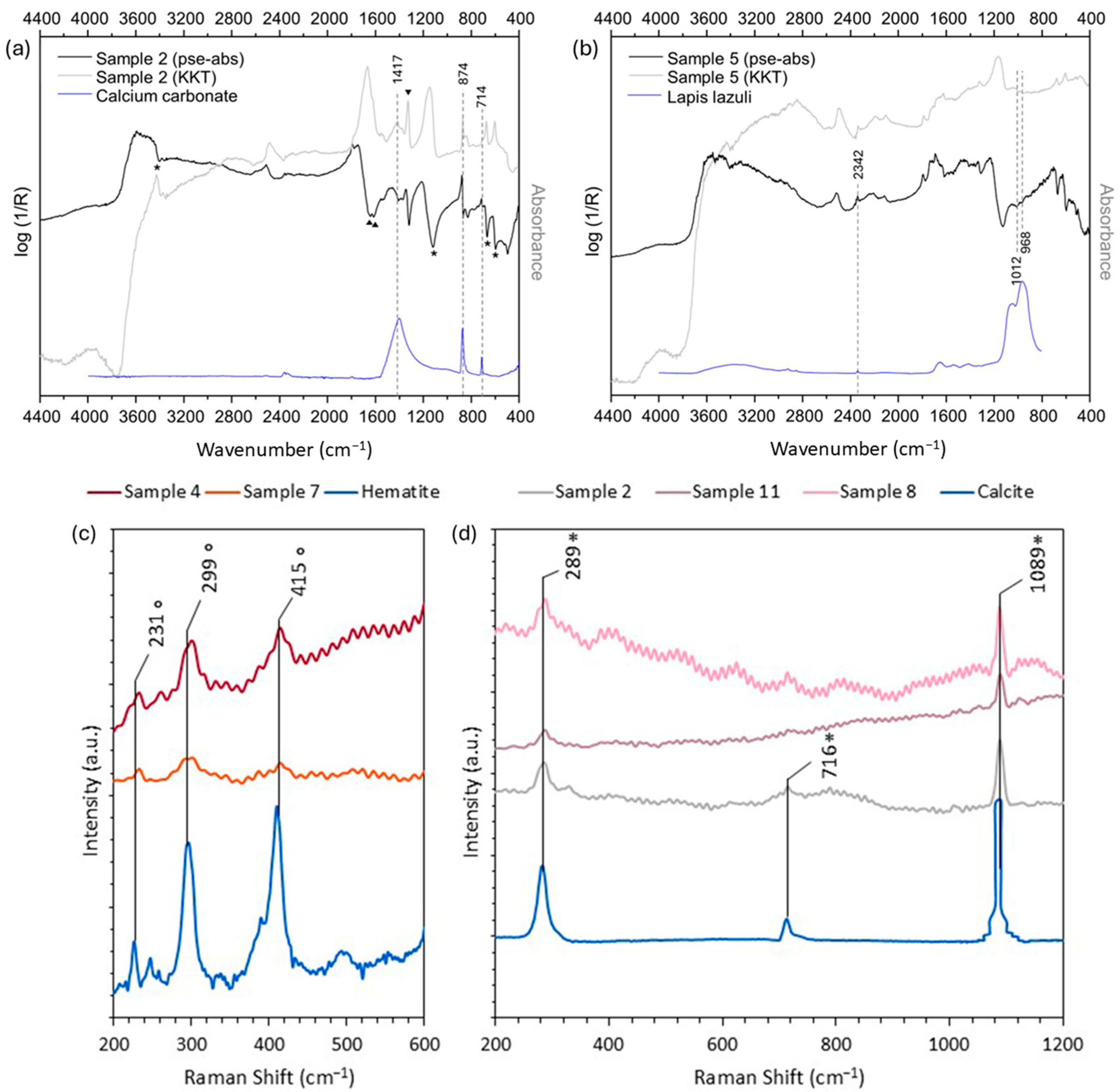
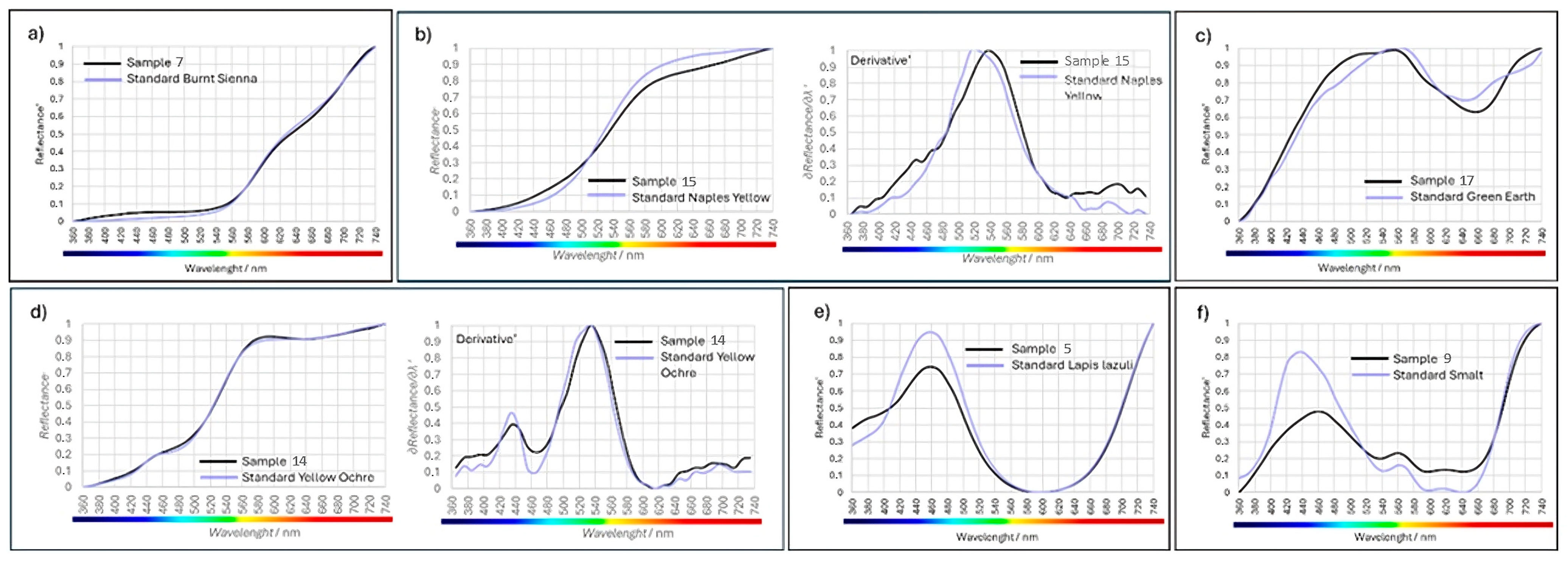

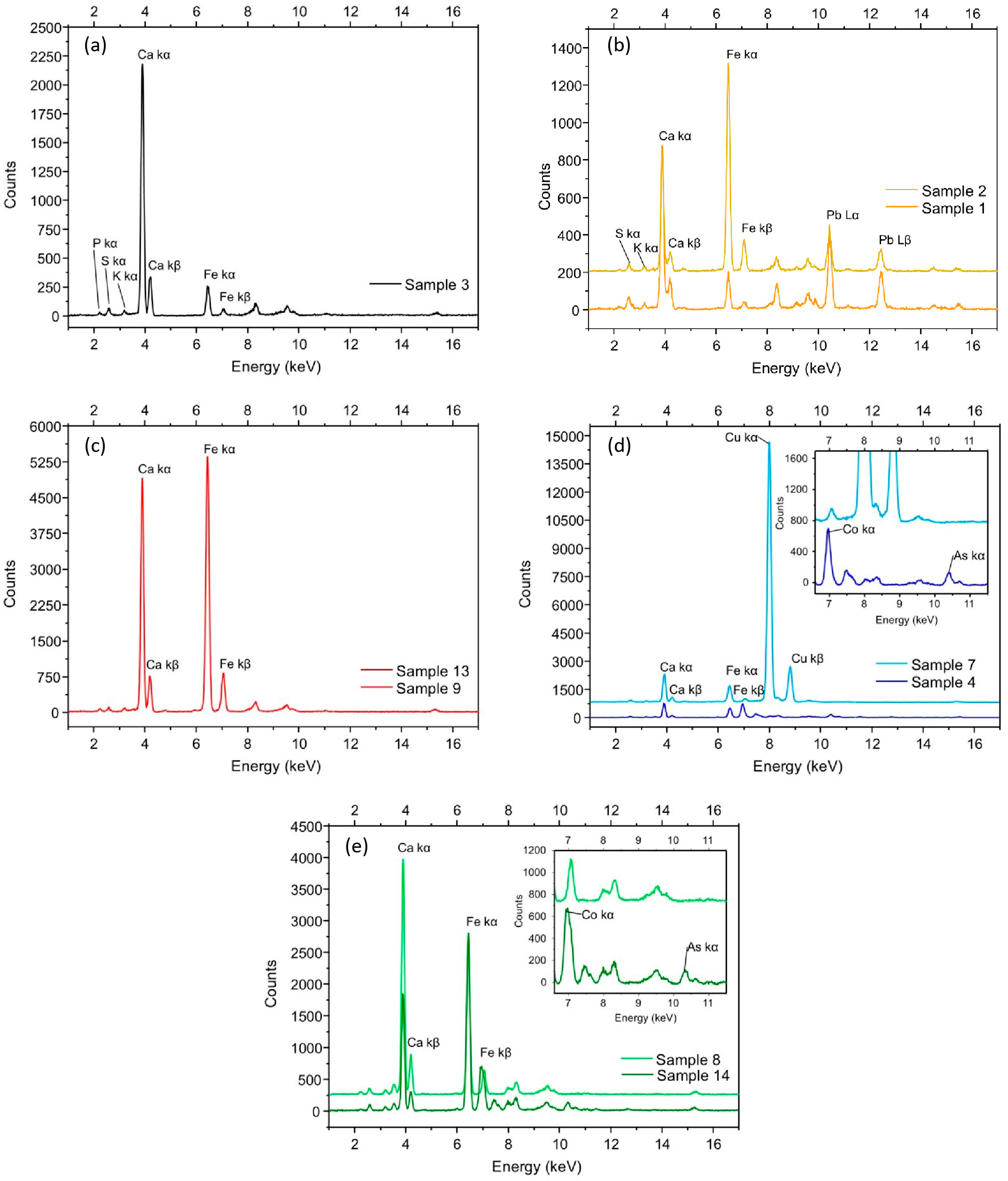
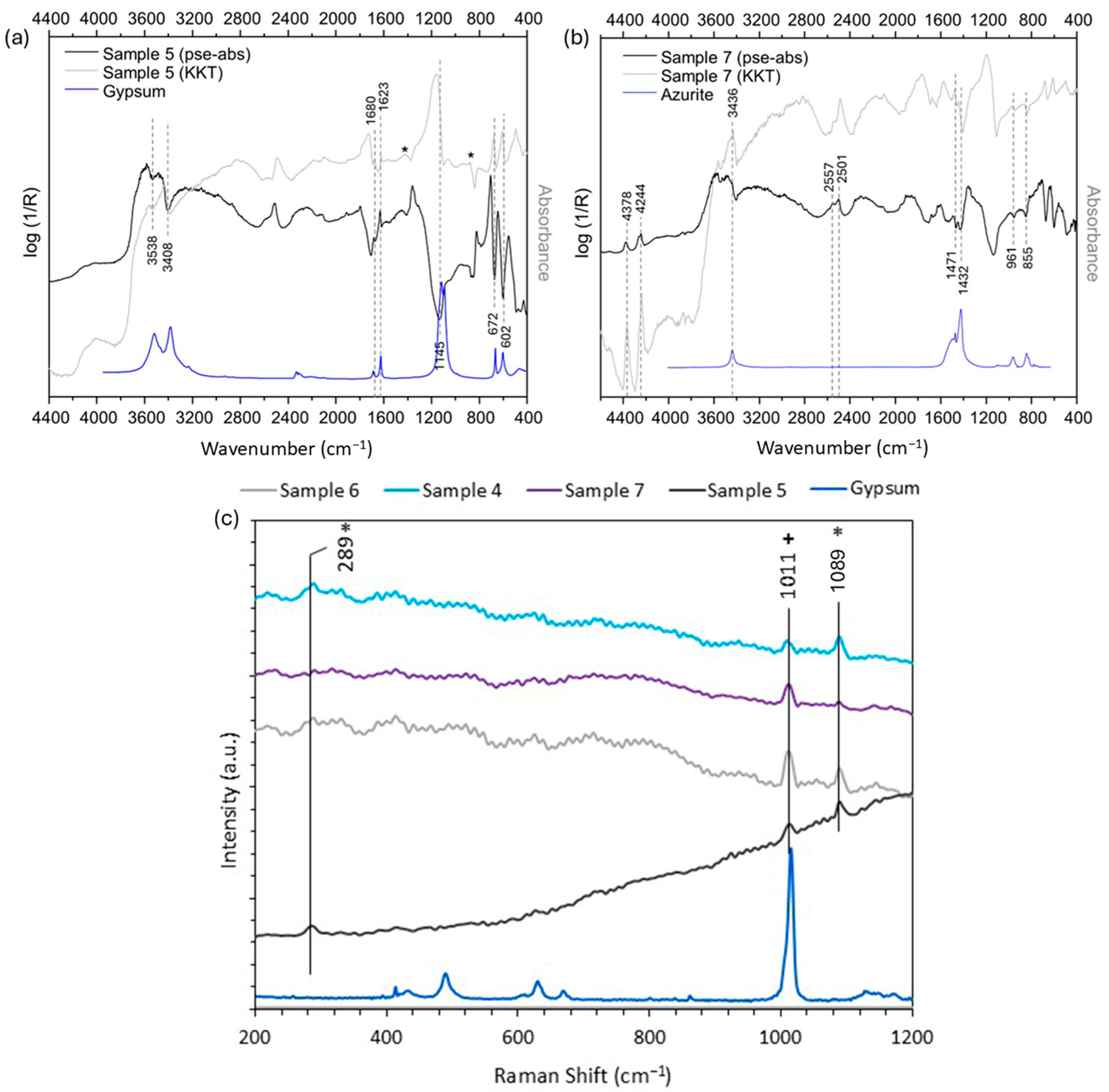
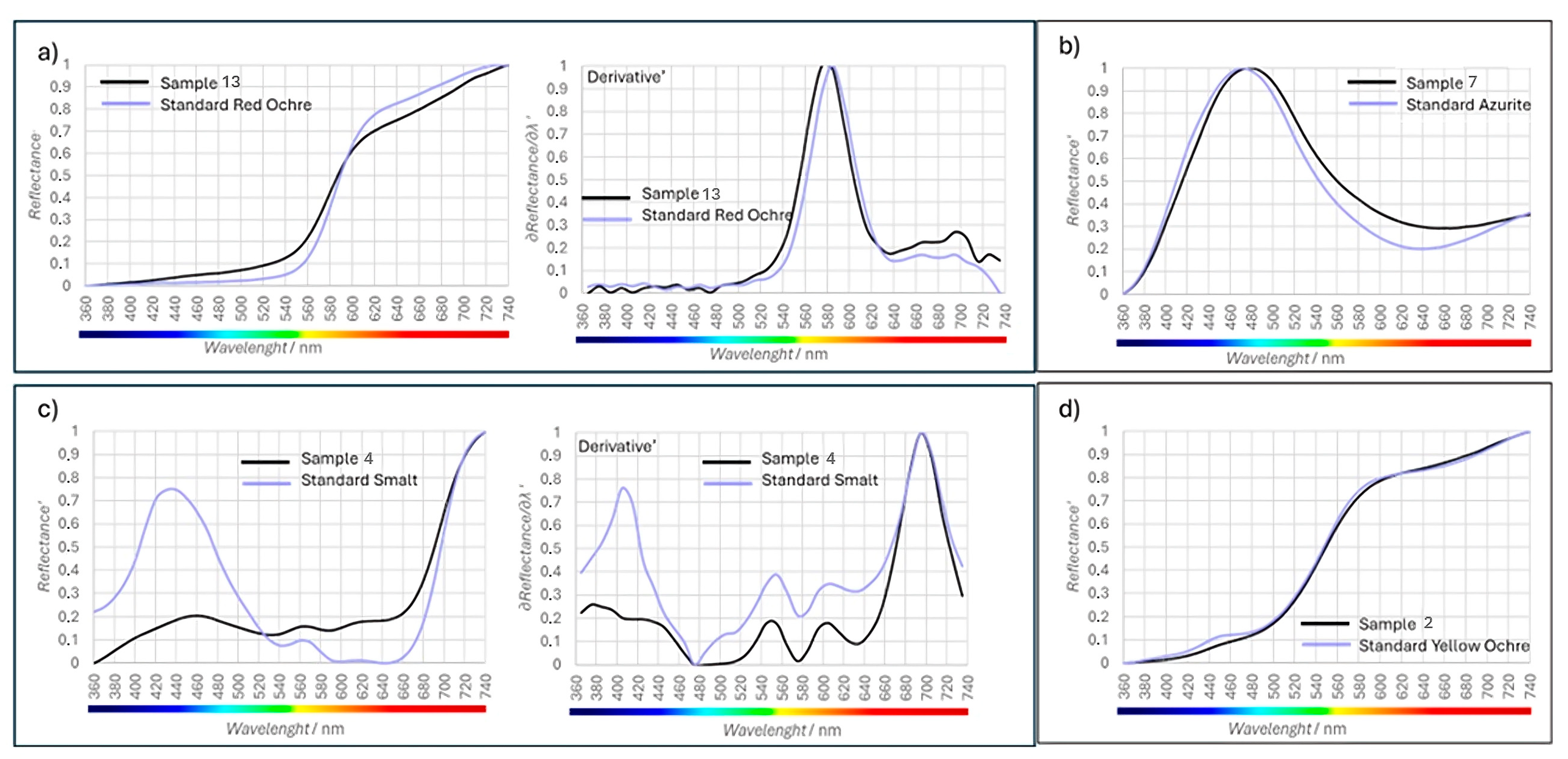


| Color | Marriage of the Virgin | Adoration of the Christ Child | XRF | Raman | ER-FTIR | Visible Reflectance | Hyperspectral | Pigment Identified |
|---|---|---|---|---|---|---|---|---|
| White | ✓ | ✓ | ✓ | ✓ | ✓ | Calcium Carbonate | ||
| Yellow | ✓ | ✓ | ✓ | ✓ | ✓ | Yellow Ochre | ||
| ✓ | ✓ | ✓ | ✓ | ✓ | Naples Yellow | |||
| Red | ✓ | ✓ | ✓ | ✓ | ✓ | ✓ | Red Ochre | |
| Blue | ✓ | ✓ | ✓ | ✓ | ✓ | Smalt | ||
| ✓ | ✓ | ✓ | ✓ | ✓ | Azurite | |||
| ✓ | ✓ | ✓ | ✓ | ✓ | Lapis Lazuli | |||
| Green | ✓ | ✓ | ✓ | ✓ | ✓ | Green Earth | ||
| ✓ | ✓ | ✓ | Smalt + Yellow Ochre * | |||||
| Purple | ✓ | ✓ | Smalt + Red Ochre * | |||||
| Gold | ✓ | ✓ | Gold Leaf |
Disclaimer/Publisher’s Note: The statements, opinions and data contained in all publications are solely those of the individual author(s) and contributor(s) and not of MDPI and/or the editor(s). MDPI and/or the editor(s) disclaim responsibility for any injury to people or property resulting from any ideas, methods, instructions or products referred to in the content. |
© 2025 by the authors. Licensee MDPI, Basel, Switzerland. This article is an open access article distributed under the terms and conditions of the Creative Commons Attribution (CC BY) license (https://creativecommons.org/licenses/by/4.0/).
Share and Cite
Verni, E.; Albano, M.; Merlo, C.; Volpi, F.; Lee, C.; Lombardi, C.A.; Comite, V.; Fermo, P.; Bergomi, A.; Guglielmi, V.; et al. Non-Invasive Multi-Analytical Insights into Renaissance Wall Paintings by Bernardino Luini. Coatings 2025, 15, 1113. https://doi.org/10.3390/coatings15091113
Verni E, Albano M, Merlo C, Volpi F, Lee C, Lombardi CA, Comite V, Fermo P, Bergomi A, Guglielmi V, et al. Non-Invasive Multi-Analytical Insights into Renaissance Wall Paintings by Bernardino Luini. Coatings. 2025; 15(9):1113. https://doi.org/10.3390/coatings15091113
Chicago/Turabian StyleVerni, Eleonora, Michela Albano, Curzio Merlo, Francesca Volpi, Chaehoon Lee, Chiara Andrea Lombardi, Valeria Comite, Paola Fermo, Andrea Bergomi, Vittoria Guglielmi, and et al. 2025. "Non-Invasive Multi-Analytical Insights into Renaissance Wall Paintings by Bernardino Luini" Coatings 15, no. 9: 1113. https://doi.org/10.3390/coatings15091113
APA StyleVerni, E., Albano, M., Merlo, C., Volpi, F., Lee, C., Lombardi, C. A., Comite, V., Fermo, P., Bergomi, A., Guglielmi, V., Borelli, M., Mariani, C., Samela, S., Vinco, L., Ghirardello, M., Rovetta, T., Fiocco, G., & Malagodi, M. (2025). Non-Invasive Multi-Analytical Insights into Renaissance Wall Paintings by Bernardino Luini. Coatings, 15(9), 1113. https://doi.org/10.3390/coatings15091113















